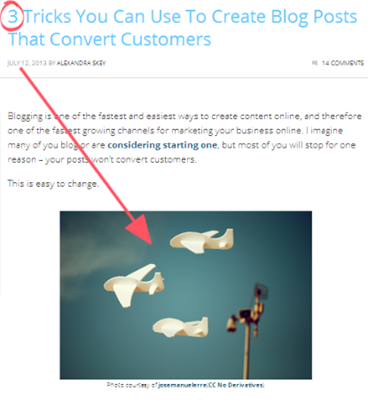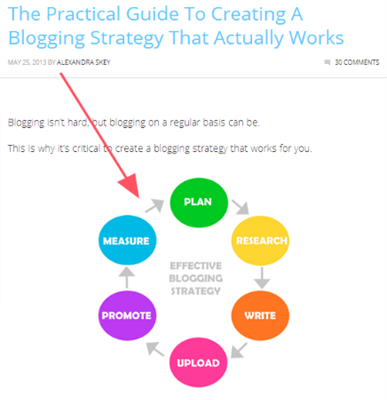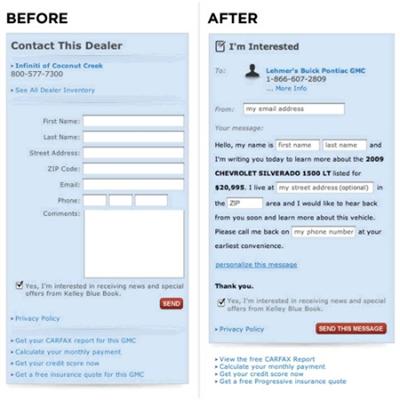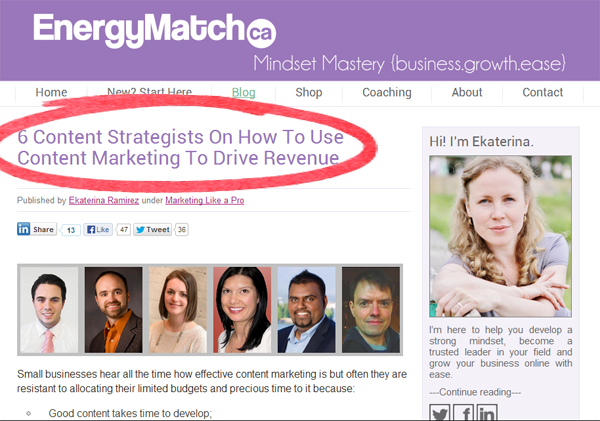Are you frustrated with your blog?
Do you ever wonder if you’re wasting time doing the wrong things?
A lot of work goes into creating a high converting blog. And part of being successful is knowing what rules you should follow, and which ones you can break.
So, here are 3 blogging taboos that you should break instantly.
1. Using Exact Images
People love pictures.
In fact, we process visuals 60,000 faster than text and we remember pictures 6 times more easily.
But in some industries exact images are hard to find. Sure, if you’re a real estate agent, a nutritionist or a fashion expert you can probably find perfect images of what you’re talking about.
However, if you’re a book keeper, a massage therapist or you’re in online marketing (like us), it’s harder.
That’s okay.
You don’t need exact images. The goal of a picture on your blog is to capture someone’s eye and illustrate or evoke an emotion. Be creative, and have fun with it.
For example, when we did a post on 3 tricks you can do to convert customers, we couldn’t find an image that reflected what I was writing about, so we focused on the number of things I was writing about – 3 – and used an image that showed 3 things in motion.
For that very special post, you may also consider creating or hiring someone to make a customized image. This works really well for posts that explain processes or steps. We used this strategy to showcase the 6 step process in The Practical Guide To Creating A Blogging Strategy That Actually Works, as you can see below.
The added benefit of customizing an image is that, in addition to your post , you can share the image on your social networks, as it will help promote the content of what you’re writing about in a visual way.
Where can you legally get images?
You can get free images from Creative Commons.org. This resource allows you to find free content from all over the web, including the creative common sections on flickr, Google images and Pixabay.
Just remember to look at the sharing restrictions.
More often than not, photographers and content creators will allow people to use their images for free, but not businesses. You can use flickr’s guidelines as a baseline of what you can – and can’t – do when sharing images that aren’t yours.
If you’re still unsure of how to find and images on your blog, read more about how to legally get the best pictures for your blog here.
Bonus
For those of you using Spokal, you have a faster option.
You can drag and drop big, beautiful and relevant photos from flickr into your post. Simply go to your sidebar and start typing ideas.
We also we automatically include the correct copyright information, and only display photos approved for commercial ventures, so you can rest easy knowing that you’re sharing beautiful (and legal) images on your blog.
2. Sounding Too Smart
Use simple language on your blog.
Even if you’re speaking to a highly educated audience.
Why?
Using natural language can increase your conversion rates. Former Chief Design Architect at Yahoo, Luke Wroblewski, tested this concept with an online form, by personalizing the language and making it simple to follow. It worked. Using natural language led to a 25-40% increase in conversions.
While he did this test using a Mad Libs style (shown below) and we’re talking about your blog, it’s clear that using natural language works to engage potential customers.
Still not convinced?
The goal of your post is to keep someone reading,* and if it’s confusing or too technical, they’ll probably get distracted and leave.
I’m not suggesting you water down what you’re saying. You may be using technical terms that need thorough explanations, or you may be exploring a complex topic. Simply present it in a way that’s easy for your readers to understand.
Breaking sections into tiny segments, using bullets for lists and adding visuals is a great way to make complex content easier to digest.
*It’s more than that. The goal of your blog is to attract potential customers and build relationships with them, so that you can convert them into customers over time.
p.s.
Ever wonder why people visit your blog?
People read your blog for a distraction, as Jon Morrow reminds us. Your goal is to entertain them when they’re bored.
Yes, they’re searching for what you do – or something you’ve written about – and yes, they want answers. And it’s your job to provide those answers in a relevant and engaging way.
3. Being The Only Expert
If you’re writing a blog about a specific topic for your business, chances are you’re trying to increase your online reach and be viewed as an expert in your field.
You’re not the only one.
While it’s important to showcase your personality, especially as a small business owner, it’s even more important to support your thoughts with research.
This is what will set you apart from the crowd.
Using facts will lend credibility, and increase the likelihood that your readers will learn something and come back for more.
Don’t worry, you’re not writing a report. Blog like you usually do, and when you’re finished, see if you can find 1 or 2 resources from reputable sources to support your thoughts. Neil Patel does a great job of this on his blog, and it’s what sparked us to include more research in our posts as well.
Showcase Your Peers
You can also showcase thoughts from other experts on your blog.
For example, business blogger Ekaterina interviewed some of her favourite content marketing professionals on how businesses can increase revenues through content marketing, and then published her findings on her blog.
As you can see, it’s a great way to showcase a variety of opinions and discover the latest trends in your industry.
Plus, when you highlight professionals in your field, there’s a higher chance those professionals will share your post, which can increase your visibility and reach through their following.
Final Thoughts: 3 Blogging Mistakes You Should Break
This post is about common blogging mistakes to stop doing.
So, what should you start doing?
Well, that depends. Do you showcase recent posts in your email signature? Use a Hello Bar to capture interested readers? Connect your blog with Google Authorship? There are some obvious ways to increase your readership that you might not be doing.
Check out these and 7 more tricks to find easy ways to increase your readership.
So, what are some of the biggest blogging taboos that you’ve broken?






